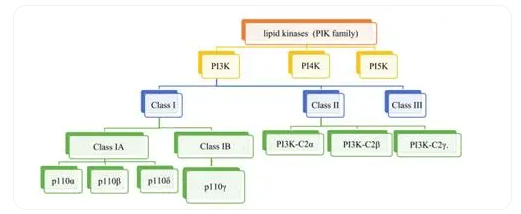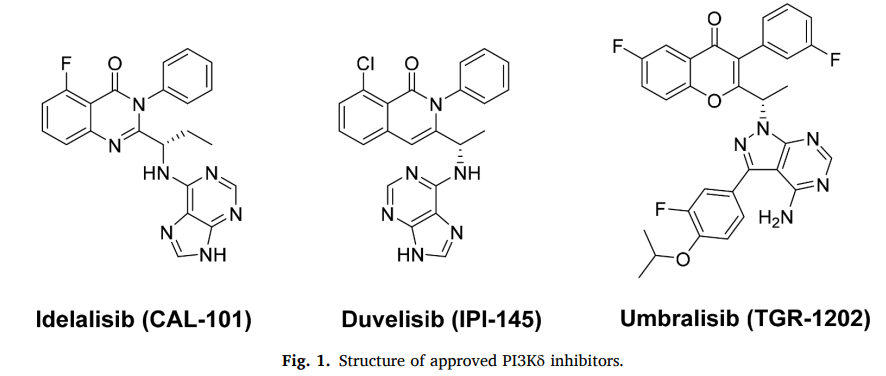PI3K is an intracellular phosphatidylinositol kinase associated with products of oncogenes such as Src and RAS. The PI3K signaling pathway is one of the most frequently activated signaling pathways in human cancer, mediating almost 50% of the occurrence of malignant tumors. Research has shown that excessive activity of the PI3K signaling pathway is significantly correlated with tumor progression, increased tumor microvascular density, and enhanced chemotaxis and invasiveness of cancer cells. At present, PI3K has become an important target for the treatment of various malignant tumors, including breast cancer and follicular lymphoma.
Introduction to PI3K targets
Phosphatidylinositol-3-kinase (PI3K) is a lipid kinase that plays a critical role in various physiological activities. PI3K can be activated through various cell surface signals, such as receptor tyrosine kinases (RTKs), small molecule GTPase proteins, and G protein coupled receptors (GPCRs).
Specifically, PI3K kinase converts phosphoinositol 4,5-diphosphate (PIP2) into the second messenger, inositol 3,4,5-triphosphate phospholipid (PIP3), under the action of ATP. Then, PIP3 further activates various downstream signaling pathways and regulates cell growth, survival, reproduction, apoptosis, metastasis, and metabolism.
Classification of PI3K inhibitors

PI3K, as a family of lipid kinases, can be classified into three main categories based on its structure and substrate specificity: Class I, II, and III. Class I is the most widely studied subtype, which can be further divided into 1A (PI3K alpha, PI3K beta, PI3K delta) and 1B (PI3K gamma), which regulate the signaling pathways of tyrosine kinase receptors and G protein coupled receptors, respectively. PI3K α and PI3K β are expressed in all tissues, and knocking out either is lethal. It is worth noting that PI3K δ and PI3K γ are highly enriched in white blood cells, and mice with PI3K δ or PI3K γ knockout or kinase inactivation can survive and have fertility, indicating the importance of subtype selectivity of PI3K inhibitors in achieving therapeutic effects. The inhibitory effect of PI3K δ has been shown to reduce the proliferation of various hematological cancer cells without impairing the survival ability of normal immune cells. Given the crucial role of PI3K δ in promoting tumor progression and its restricted expression in white blood cells, inhibiting PI3K δ kinase is a unique opportunity for treating hematological malignancies.
The development of PI3K drugs
In 2014, the PI3K δ inhibitor Idelalisib was approved by the US Food and Drug Administration for the treatment of relapsed chronic lymphocytic leukemia (CLL), follicular lymphoma (FL), small lymphocytic lymphoma (SLL), and non Hodgkin's lymphoma (NHL).

References:
1.Cantley LC. The phosphoinositide 3-kinase pathway. Science.
2002;296:1655–1657.
2.Vivanco I, Sawyers CL. The phosphatidylinositol 3-kinase-AKT pathway in human cancer. Nat Rev Cancer.
2002;2:489–501.
3.Fruman DA, Chiu H, Hopkins BD, Bagrodia S, Cantley LC, Abraham RT. The PI3K pathway in human disease. Cell.
2017;170:605–635.
4.Osaki M, Oshimura M, Ito H. PI3K-Akt pathway: Its functions and alterations in human cancer. Apoptosis.
2004;9:667–676.
5.Fruman DA, Rommel C. PI3K and cancer: lessons, challenges and opportunities. Nat Rev Drug Discovery.
2014;13:140–156.
6.Thorpe LM, Yuzugullu H, Zhao JJ. PI3K in cancer: divergent roles of isoforms, modes of activation and therapeutic targeting. Nat Rev Cancer.
2015;15:7–24.
7.Engelman JA, Luo J, Cantley LC. The evolution of phosphatidylinositol 3-kinases as regulators of growth and metabolism. Nat Rev Genet.
2006;7:606–619.
8.Liu PX, Cheng HL, Roberts TM, Zhao JJ. Targeting the phosphoinositide 3-kinase pathway in cancer. Nat Rev Drug Discov.
2009;8:627–644.
9.Vanhaesebroeck B, Ali K, Bilancio A, Geering B, Foukas LC. Signalling by PI3K isoforms: insights from gene-targeted mice. Trends Biochem Sci.
2005;30:194–204.
10.Samuels Y, Ericson K. Oncogenic PI3K and its role in cancer. Curr Opin Oncol.
2006; 18:77–82.
11.Yang QS, Modi P, Newcomb T, Queva C, Gandhi V. Idelalisib: First-in-class PI3K delta inhibitor for the treatment of chronic lymphocytic leukemia, small lymphocytic leukemia, and follicular lymphoma. Clin Cancer Res.
2015;21:1537–1542.
12.Garces AE, Stocks MJ. Class 1 PI3K clinical candidates and recent inhibitor design strategies: a medicinal chemistry perspective. J Med Chem.
2019;62:4815–4850.
13.Greenwell IB, Flowers CR, Blum KA, Cohen JB. Clinical use of PI3K inhibitors in Bcell lymphoid malignancies: today and tomorrow. Expert Rev Anticanc.
2017;17: 271–279.